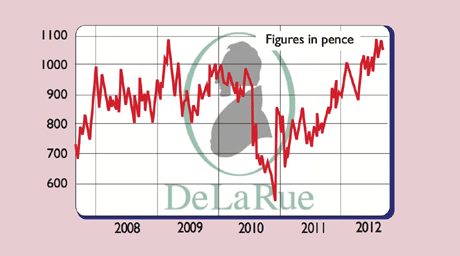
De La Rue’s profits are recovering, but any upside is priced in, says Phil Oakley.
The business
De La Rue is the world’s largest commercial printer of banknotes. It provides governments and central banks with top-quality banknote paper, printed banknotes and security features to stop counterfeiters. During the last five years it has produced banknotes for more than 150 national currencies.
It also provides customers with cash processing services, such as banknote sorters and cash management software. The firm’s expertise in banknote security has allowed it to provide other secure printed products. These include travellers’ cheques, passports, driving licences and ID cards. De La Rue had sales of £528m in 2011/2012.
The history
The business began life in 1813 when Thomas De La Rue published Le Miroir Politique newspaper in Guernsey. He moved to London in the 1820s and set himself up as a printer and stationer. The 1830s saw him awarded a royal patent to produce playing cards. During the 1850s, the company moved into printing stamps. 1860 saw De La Rue print its first paper money, the Mauritius one, five and ten shilling notes. It wasn’t until 1914 that it printed money in Britain.
After World War II, De La Rue expanded abroad and started moving into other areas, such as banknote printing equipment. In 1967 it designed and installed the first hole-in-the-wall cash machine in Britain.
The firm’s recent history has been mixed. During the last decade it has started printing money for the Bank of England (rather than just supplying it with banknote paper) and has won a contract to print British passports.
In 2010 its reputation was severely damaged when some of its banknotes were deemed not up to standard after it turned out that specification test certificates had been falsified. The scandal saw De La Rue’s profits and share price collapse. This led to French currency maker Oberthur trying and failing to take over the company. De La Rue is now trying to get profits back to the levels of a few years ago.
The chief executive
Tim Cobbold has been chief executive since January 2011. Prior to that he was in charge of Chloride Group plc, a secure-power services company. He started out as a mechanical engineer before training to be an accountant and spent a large part of his career at Smiths Group. Having seen off a French bidder, getting De La Rue’s profits to respectable levels again is a big challenge for him. He was paid just over £1m last year.
Should you buy the shares?
Printing banknotes looks to be a pretty good business. Barriers to entry, such as reputation and security, make it quite difficult for potential competitors. This means that firms such as De La Rue should make good profits. Despite more of us using debit and credit cards or transferring money electronically, the number of banknotes is expected to keep growing. This should be good news for De La Rue. The market for banknote paper looks less promising, though, with too much capacity in the market.
There has been some excitement about what a break-up of the eurozone might mean for De La Rue’s fortunes. Some hope that it could see the return of national currencies and a bonanza for the company. This looks wide of the mark. Even if the single currency did break up, most countries have their own banknote printing companies to help restore national currencies again.
De La Rue is a profit recovery story. A combination of sales growth and cost cutting is aiming to take operating profits to more than £100m in two years’ time from just over £60m now. In the absence of another takeover bid, the recovery looks priced into the shares. The dividend yield is quite attractive, but is thinly covered by profits. This and a big pension fund deficit means that dividends are unlikely to grow much. We’d avoid the shares for now.
The numbers
Stockmarket code: DLAR
Share price: 1,047p
Market cap: £1,042m
Net assets (March 2012): £(46m)
Net debt (March 2012): £25m
P/e (current year estimate): 18.2 times
Yield (prospective): 4.0%
What the analysts say
Buy: 2
Hold: 6
Sell: 1
Average price target: 1,030p
Directors’ shareholdings
T Cobbold: 14,813
C Child: 14,813
W East: 4,314